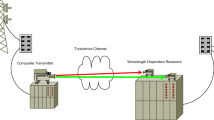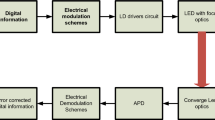Abstract
This manuscript investigates various performances of pulse position modulation–subcarrier intensity modulation (PPM-SIM) model under various environmental conditions. The considered PPM is pulse shaped by half-cosine pulse and modulated over an orthogonal subcarrier signal. This system is analyzed under various atmospheric turbulences like log-normal (weak) and gamma-gamma (strong) for various environmental conditions like rain and dense fog of minimal visibility. The impact of environmental conditions on the performance parameters like bit error rate (BER) and information capacity is numerically analyzed for a comparative analysis. This manuscript aims to study the feasibility of a spectral efficient PPM based free-space optics (FSO) system for various adverse weather conditions.
Access provided by Autonomous University of Puebla. Download conference paper PDF
Similar content being viewed by others
Keywords
1 Introduction
FSO is the communication system where free-space (i.e., air/vacuum) is used as the communication medium. FSO is an optical communication system where data are transmitted through free-space medium using light as the propagating wave. Its function is analogous to fiber optics communication apart from the transmission medium. High information capacity, immune to electro-magnetic interference, unregulated frequency spectrum, low installation cost, etc., are the attributes through which the FSO system has gained popularity since some decades past. Atmospheric turbulences due to temperature and pressure variation and presence of foreign elements like rain, fog, and haze limit the propagation distance of optical signal up to few hundred meters [1]. The FSO channel is a random time-varying channel model represented by log-normal and gamma-gamma mathematical models, respectively, for weak and strong atmospheric turbulences [2, 3].
Going through performance study of various modulation techniques since 2010 [4,5,6,7,8,9,10,11], pulse position modulation (PPM) has obtained maximum preference due to its superior error performance results. Because of the above cause, authors [2] have proposed a hybrid modulation technique based on PPM for cellular back-haul application. Further, the authors [12] have proposed a new kind of system design by which the poor spectral efficiency of PPM can be overcome and to make it eligible as a spectral efficient modulation for cellular back-haul application. Though, PPM has been studied under various atmospheric turbulences such as weak and strong, its performances for various weather conditions are left untouched. Hence, this manuscript analyzed the error performance study and maximum capacity study under the influence of atmospheric turbulences and various weather conditions like dense fog and rain. At the end, a conclusive statement on performance degradation in dB for rain and dense fog is drawn for the PPM based back-haul FSO system model.
2 System and Channel Model
The considered system is a PPM based system [12], where every PPM symbol is pulse shaped by a half-cosine signal. This method is to reduce the inter channel interference (ICI) caused by frequency deviation due to fading. The system model in [12] has multiplied a subcarrier orthogonal frequency to each parallel output line of the PPM encoder. This novel model of PPM encoder has shown significance spectral advantages over traditional PPM encoder [13]. During the propagation of laser beam, optical signal undergoes fading. For weak atmospheric turbulence, this fading channel model can be represented by log-normal distribution, and for strong atmospheric turbulence, gamma-gamma model is widely accepted. Though, the authors have analyzed the system performances under diverse atmospheric turbulence conditions, the weather conditions like dense fog and rain are not considered as a part of deteriorating factor for the light wave. This manuscript incorporates the effects of fog and rain on the exposed light signal.
The attenuation due to fog and rain is given by (1) [14, 15]
V is the visibility in km, λ is the operating wavelength in nm, and δ is the parameter related to the particle size distribution and V. Kim model is suitable for low visibility due to dense fog and heavy rain. δ by the Kim model is given by.
δ = | 1.6 | V > 50 km |
1.3 | 6 km < V < 50 km | |
0.16 V + 0.34 | 1 km < V < 6 km | |
V–0.5 | 0.5 km < V < 1 km | |
0 | V < 0.5 km |
In this manuscript, we have chosen the value of δ = 0.16 V + 0.34 for rain attenuation at a visibility between 1 and 2 km. However, for dense fog attenuation, δ = 0 at a visibility within 0.2 km. Hence, for dense fog situation, the atmospheric channel attenuation becomes independent of wavelength.
The overall error probability under the weak and strong atmospheric turbulence is given by (2) and (3)
where
3 Result and Discussion
Figure 1 represents the BER plot as a function of received average irradiance for weak and strong atmospheric turbulence. The numerical results prove their ideality under the rainy atmospheric condition of visibility within 2 km. For weak atmospheric turbulence, i.e., scintillation, half-cosined PPM is about 8 dBm power efficient over PPM at a fixed BER level of \({10^{ - 15}}\). For higher atmospheric turbulence, i.e., when we consider gamma-gamma channel model, the improvement in half-cosined PPM persists, but at 5 dBm more power efficiency.
The BER plot as a function of received average irradiance for weak and strong atmospheric turbulence is shown in Fig. 2. The numerical results prove their nature likewise in Fig. 1. Under the dense fog atmospheric condition of visibility within 0.2 km, the obtained results show a significant degradation in error performances. For weak as well as strong atmospheric turbulences, half-cosined PPM and PPM are about 20 dBm less power efficient over rainy atmospheric condition.
This result in Fig. 3 compares the error performances under rainy and dense fog environmental condition. For weak atmospheric turbulence, the system BER performance decays at a rate of \({10^5}\) times for dense fog environment over rainy environment at a distance of 2 km. In other way, we roughly can conclude that at a reference bit error rate of \({10^{ - 10}}\), the light can travel 500 m more in rainy condition than in dense fog condition.
This result of Fig. 4 is the evaluation of average link capacity comparison for dense fog and rainy environment under weak atmospheric turbulence. Because of the high signal-to-noise ratio (SNR) value of half-cosine PPM, it maintains highest capacity of about 1 and 2.5 Gbps more data rate over PPM-MSK and PPM, respectively, at 10 dBm received optical power. Though, the improvement in data rate is observed with increase in received optical power, the system rate is approximately 15 Gbps higher in case of rainy atmospheric condition over dense fog condition.
4 Conclusion
In this manuscript, authors have explored the environmental attenuation on a new model of HC-PPM-OFDM without serial conversion of PPM. Authors have numerically studied and compared some vital parameters like BER and capacity under both rainy and dense fog weather conditions. Finally, we conclude that the fog attenuation is more deteriorating than the attenuation by rain. Fog attenuation can limit our transmission distance up to 1.6 km which is around 600 m less than the rain attenuation.
References
Sahoo PK, Prajapati YK, Tripathi R (2018) PPM- and GMSK-based hybrid modulation technique for optical wireless communication cellular backhaul channel. IET Commun 12(17):2158–2163
Sahoo PK, Yadav AK, Prajapati YK, Tripathi R (2019) Phase‐sampled detection of hybrid modulation impaired by gamma‐gamma turbulence. Microw Opt Technol Lett 1–8
Esmail MA, Fathallah H, Alouini MS (2016) Outdoor FSO communications under fog: attenuation modeling and performance evaluation. IEEE Photonics J 8(4):1–22
Ma J, Jiang Y, Yu S et al (2010) Packet error rate analysis of OOK, DPIM and PPM modulation schemes for ground-to-satellite optical communications. Opt Commun 283(2):237–242
Dabiri MT, Sadough SMS, Khalighi MA (2017) FSO channel estimation for OOK modulation with APD receiver over atmospheric turbulence and pointing errors. Opt Commun 402:577–584
Popoola WO, Ghassemlooy Z (2009) BPSK subcarrier intensity modulated free-space optical communications in atmospheric turbulence. J Lightw Technol 27(8):967–973
Sahoo PK, Prajapati YK, Tripathi R (2020) Hybrid mapped optical-OFDM using nonlinear companding technique for indoor visible light communication application. IET Commun 14(17):3073–3079
Dubey D, Prajapati YK, Tripathi R (2020) Performance enhancement of hybrid-SIM for optical wireless downlink communication with aperture averaging and receiver diversity. IET Commun 14(18):3194–3202
Sahoo PK, Yadav A (2020) A comprehensive road map of modern communication through free-space optics. J Opt Commun https://doi.org/10.1515/joc-2020-0238
Chen Y, Li Z, Liu P et al (2017) The BER performance comparison of MSK and GMSK schemes for short-range visible light communication. In: IEEE 9th international conference on communication software and networks (ICCSN). Guangzhou, pp 611–614
Ghassemlooy Z, Popoola W, Rajbhandari S (2012) Optical wireless communications: system and channel modeling with MATLAB. CRC, New York, NY, USA
Sahoo PK, Prajapati YK, Tripathi R (2019) Performance analysis of pulse position modulation-based hybrid technique for cellular backhaul free-space optical link. Opt Eng 58(1):016119
Liu H, Liao R, Wei Z, Hou Z, Qiao Y (2015) BER analysis of a hybrid modulation scheme based on PPM and MSK subcarrier intensity modulation. IEEE Photonics J 7(4):7201510–7201520
Ghoname S, Fayed HA, El Aziz AA, Aly MH (2016) Performance analysis of FSO communication system: effects of fog, rain and humidity. In: Sixth international conference on digital information processing and communications (ICDIPC). Beirut, pp 151–155
Sahoo PK, Yadav AK, Prajapati YK, Tripathi R (2020) Optimum APD gain evaluation of FSO system for inter-building laser communication application. InL Advances in VLSI, communication, and signal processing. Lecture notes in electrical engineering, vol. 587. Springer
Author information
Authors and Affiliations
Corresponding author
Editor information
Editors and Affiliations
Rights and permissions
Copyright information
© 2021 The Author(s), under exclusive license to Springer Nature Singapore Pte Ltd.
About this paper
Cite this paper
Sahoo, P.K. (2021). PPM-SIM Based FSO System Under Various Environmental Conditions. In: Chakraborty, M., Jha, R.K., Balas, V.E., Sur, S.N., Kandar, D. (eds) Trends in Wireless Communication and Information Security. Lecture Notes in Electrical Engineering, vol 740. Springer, Singapore. https://doi.org/10.1007/978-981-33-6393-9_5
Download citation
DOI: https://doi.org/10.1007/978-981-33-6393-9_5
Published:
Publisher Name: Springer, Singapore
Print ISBN: 978-981-33-6392-2
Online ISBN: 978-981-33-6393-9
eBook Packages: EngineeringEngineering (R0)








